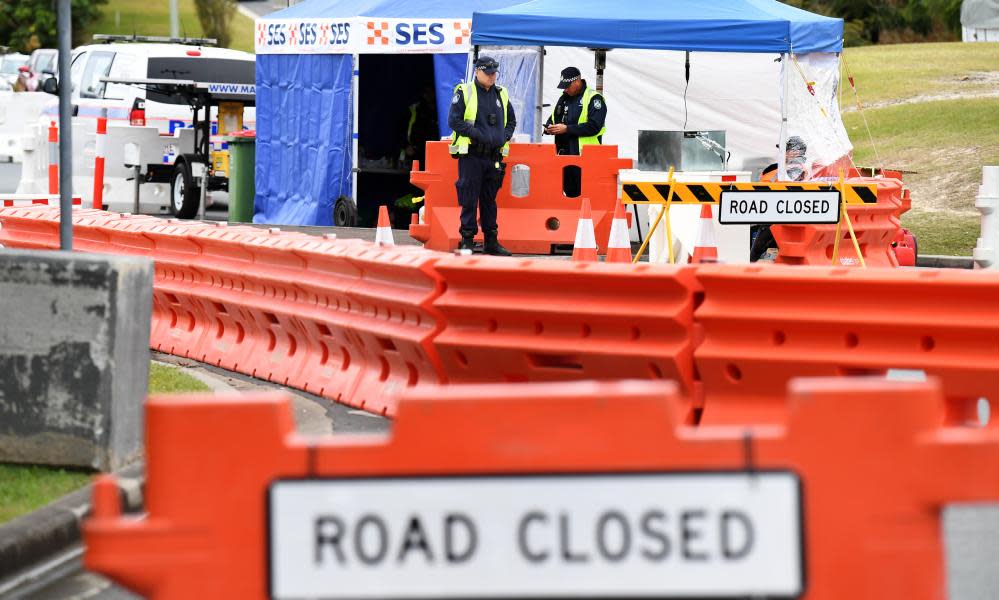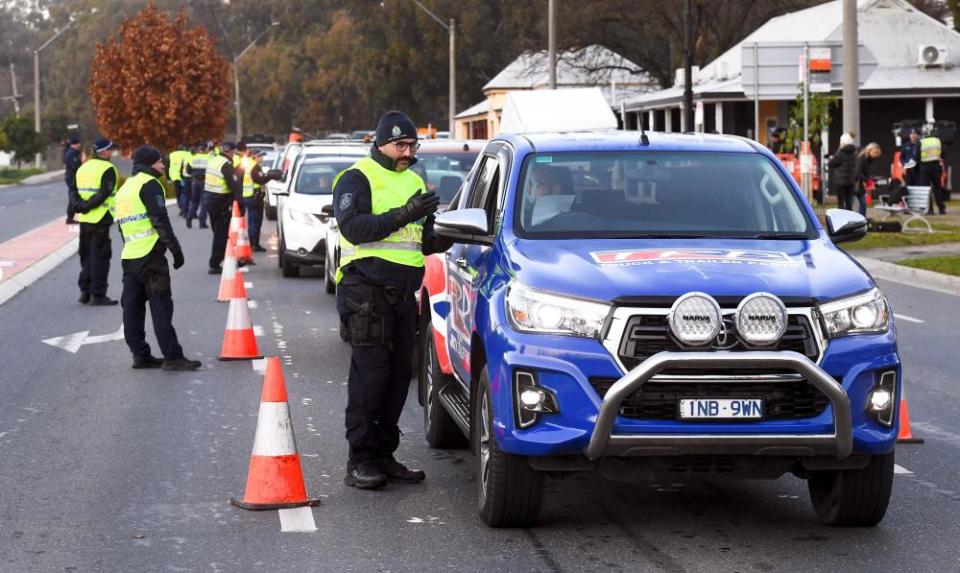Australia's Covid-19 border restrictions: where you can travel to and from

After several months of lockdown, Australians everywhere are itching to travel. With international borders closed for the foreseeable future, domestic tourism is becoming an increasingly attractive option. But as Victoria and New South Wales try to contain a second wave of coronavirus cases, different Australian states and territories have imposed varying restrictions on travel.
Here’s what we know about where you can go and where you can’t based on where you’re coming from. And beware that those caught breaching border rules could face stiff fines in some states.
default
New South Wales
NSW imposed border restrictions with Victoria from 8 July, meaning only valid permit holders are allowed to enter NSW and once they do they must self-isolate for 14 days.
On 22 July, NSW tightened those border restrictions and entry is not permitted unless strict criteria is met. Permits issued under the previous restrictions are no longer valid and people wishing to enter must apply for a new permit on the Service NSW website.
NSW residents who travel to Victoria can return, but they must apply for a permit and isolate for 14 days when they arrive. More information about who is eligible for a permit can be found on the NSW government website.
Visitors entering NSW from states and territories aside from Victoria don’t need to quarantine.
Most NSW residents can travel to Queensland, however travellers who have been in Campbelltown, Liverpool or Fairfield local government areas will be turned away at the border. The Queensland premier, Annastacia Palaszczuk, indicated on Thursday that she has not ruled out declaring more areas in NSW hotspots.
Residents can travel to Tasmania if they haven’t been in a designated hotspot, but they will be required to undertake government-supervised quarantine.
Only those with exemptions can travel to Western Australia.
People travelling to South Australia will be required to self-isolate for 14 days.
Those travelling to the Northern Territory who have been in a declared hotspot will be required to undertake government-supervised quarantine at a cost of $2,500 per person. The entire Greater Sydney region is now classified as a hotspot.

Victoria
No permit or approval is required to enter Victoria from another state, however some state premiers have recommended residents should not travel to Victoria, given the current outbreaks.
Victoria’s border with NSW has been closed since 8 July, with those wishing to enter NSW requiring a permit.
Related: Victoria Covid-19: Melbourne's stage 3 lockdown rules explained
Victorians wishing to enter South Australia also require pre-approval.
Residents of Victoria are not allowed to travel to Queensland, Tasmania, WA, NT or the ACT without an exemption.
Queensland
Any person who has been in a declared Covid-19 hotspot during the past 14 days, including Victoria and the NSW local government areas of Campbelltown, Liverpool and Fairfield, cannot enter Queensland and will turned away at the border.
Exemptions exist for returning residents who will be subject to government-directed quarantine. Exemptions are available in some other limited circumstances which can be found here.
From 10 July, people travelling from WA, SA, Tasmania, the ACT, the NT and non-hotspot areas of NSW may enter Queensland if they complete a border declaration and undertake to present for a Covid-19 test if they develop symptoms.
There are no restrictions on travel from Queensland to NSW, SA, the ACT or the NT, however the Queensland government is urging its residents not to travel to any known Covid-19 hotspots.
Travellers to Tasmania will be required to self-isolate for 14 days when they arrive in the state.
People from Queensland can’t travel to WA unless they have an exemption.
Related: Clive Palmer-backed court challenge to Queensland Covid-19 border closure dropped
Tasmania
The Tasmanian border is currently closed to anyone travelling from Covid-19-affected areas, including Victoria, unless they are authorised travellers or returning residents. Unauthorised travellers from these regions will be turned around at the border at their own cost.
All travellers to Tasmania, including returning residents, must currently self-isolate for 14 days upon arrival. Non-Tasmanian residents must carry out their quarantine in government-provided accommodation.
From 7 August visitors from SA, the NT and WA may enter without going into quarantine, but they must apply first and declare that they have not been in New South Wales, Victoria, Queensland or the ACT in the preceding 14 days. Travellers from the “safety bubble” states will have to undergo a mandatory health check upon arrival, and anyone with coronavirus symptoms will have to take a mandatory test, and remain in hotel or home quarantine until the results are received. All travellers from the other states, including returning residents, must quarantine for 14 days upon arrival. Non-Tasmanian residents must carry out their quarantine in government-provided accommodation.
Under a new online travel registration system, G2G Pass, all travellers need a QR code to enter Tasmania. People previously granted “essential traveller” status need to reapply through the new system. More information about Tasmanian border rules is available on the Tasmanian government website.
There are no restrictions on travel from Tasmania to NSW, Victoria, Queensland, South Australia, the NT and the ACT, however returning residents will be required to self-isolate for 14 days.
People can’t travel from Tasmania to WA without an exemption.
Western Australia
No travellers are allowed to enter Western Australia unless they are granted an exemption upon application via G2G Pass .
On 20 July the WA government tightened the rules around exemptions for anyone who has travelled from or through NSW or Victoria, and exemptions granted prior to that date are no longer valid. The criteria for exemptions is outlined here.
Travel is permitted through most regional areas of Western Australia, except for remote Aboriginal communities.
Everyone entering WA is required to bring their own masks.
There are no restrictions on travel from WA to NSW, Victoria, Queensland, South Australia, the NT and the ACT, but residents who wish to return must apply for an exemption to enter WA.
Those travelling to Tasmania are currently required to self-isolate for 14 days when they arrive in the state and apply for an exemption upon return. From 7 August residents travelling to Tasmania may enter the state without going into quarantine, but they must apply first and declare that they have not been in New South Wales, Victoria, Queensland or the ACT in the preceding 14 days. Travellers will have to undergo a mandatory health check upon arrival, and anyone with coronavirus symptoms will have to take a mandatory test, and remain in hotel or home quarantine until the results are received.
Residents returning from Victoria may be required to undertake 14 days government-supervised quarantine.
Residents returning from NSW must self-isolate for 14 days.
South Australia
The South Australian border is now closed to Victorian residents, unless they are deemed an “essential traveller”. Checkpoints are set up at all border crossings between South Australia and Victoria and travellers must enter the state via one of the roads listed here.
Essential travellers living in cross-border communities can still enter South Australia, however they cannot travel further than 50km over the border.
Travellers from ACT and NSW, other than essential travellers, will be required to self-isolate for 14 days after entering the state and submit for Covid-19 testing on the day of arrival and day 12 following arrival.
People from Queensland, WA, the NT and Tasmania can enter South Australia without having to quarantine for 14 days, but all travellers must be pre-approved via the cross-border travel registration. More information is available on the South Australian government website.
There are no restrictions on travel from SA to NSW, Victoria, Queensland, the NT and the ACT, but residents who wish to return must apply for pre-approval to enter SA.
Those travelling to Tasmania are currently required to self-isolate for 14 days when they arrive in the state and apply for pre-approval upon return. From 7 August residents travelling to Tasmania may enter the state without going into quarantine, but they must apply first and declare that they have not been in New South Wales, Victoria, Queensland or the ACT in the preceding 14 days. Travellers will have to undergo a mandatory health check upon arrival, and anyone with coronavirus symptoms will have to take a mandatory test, and remain in hotel or home quarantine until the results are received.
Those travelling to WA require an exemption to enter the state and must apply for pre-approval upon return.
Residents returning from some areas will be required to self-isolate for 14 days, which will be notified within 72 hours of the submission of a registration for pre-approval. SA residents will not be allowed to return to their state from Victoria unless they are essential travellers. As of 28 July, this restriction was hardened, removing the ability for a resident to return from Victoria and quarantine for 14 days.
Northern Territory
Anyone arriving in the Northern Territory must complete a border entry form. People who have travelled from or through a declared hotspot in the last 14 days must undertake 14 days’ mandatory supervised quarantine at a cost of $2,500 per person. That now includes Victoria, the entire Greater Sydney region and Port Stephens.
Exemptions granted before 17 July are invalid for people who have travelled through hotspots. Travellers can apply for an exemption in limited circumstances.
The NT government is urging people travelling from hotspots or residents planning travel to hotspots to cancel their plans.
The NT government points travellers to a Google map with current hotspots and a Q&A guide on its website.
There are no restrictions on travel from NT to NSW, Victoria, Queensland, SA and the ACT, but residents who wish to return must complete a border entry form and will be required to undertake government-supervised quarantine at a cost of $2,500 per person if they have travelled through a hotspot.
Those travelling to Tasmania are currently required to self-isolate for 14 days when they arrive in the state. From 7 August residents travelling to Tasmania may enter the state without going into quarantine, but they must apply first and declare that they have not been in New South Wales, Victoria, Queensland or the ACT in the preceding 14 days. Travellers will have to undergo a mandatory health check upon arrival, and anyone with coronavirus symptoms will have to take a mandatory test, and remain in hotel or home quarantine until the results are received.
Those travelling to WA require an exemption to enter the state.
ACT
People who are not ACT residents may not enter the ACT from Victoria, unless they hold an exemption. ACT residents are required to self-isolate for 14 days after leaving Victoria.
Currently public health orders require anyone who has been in affected locations in NSW, as identified by NSW Health, to self-quarantine for 14 days from the date they were there, even if they do not have any symptoms. More information can be found on the ACT government website.
There are no restrictions on travellers entering the ACT from other states and territories.
The ACT government is urging residents not to travel to locations with Covid-19 outbreaks, which includes all travel to Victoria and some locations in NSW.
There are no restrictions on travel from ACT to NSW, Victoria, Queensland, SA and the NT, but residents returning from Victoria or Covid-19 hotspots in NSW must self-isolate for 14 days.
Those travelling to Tasmania will be required to self-isolate for 14 days when they arrive in the state.
Those travelling to WA require an exemption to enter the state.
Due to the unprecedented and ongoing nature of the coronavirus outbreak, this article is being regularly updated to ensure that it reflects the current situation at the date of publication. Any significant corrections made to this or previous versions of the article will continue to be footnoted in line with Guardian editorial policy.

 Yahoo News
Yahoo News 
